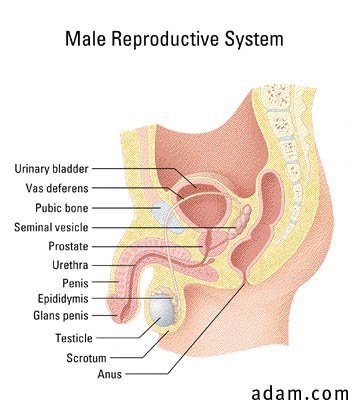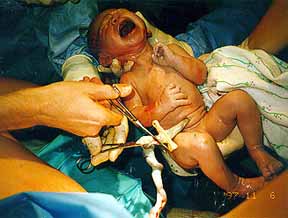
Reproduction
and Development

The reproductive system makes it possible for organisms to pass on
their
genes to the next generation. There are many different ways to
accomplish
the task, but ultimately new individuals will develop and enter the
world.
In this section you will get a brief introduction to the different
types
of reproduction among animals. We will focus on the the reproductive
anatomy
of humans and our own development during the nine months in the womb.
The following questions will
help you to review the material from the lecture, the laboratory, as
well
as the text.
- What is the overall
goal
and purpose
of the reproductive system in animals?
- Define asexual
reproduction.
- What are the
advantages
with asexual
reproduction? Disadvantages?
- Briefly describe the
processes
of fission, budding and fragmentation and how these exemplify asexual
reproduction?
- Define the process
of
parthenogenesis
(use aphids and whiptail lizards as examples).
- What are the
advantages
with sexual
reproduction? Disadvantages?
- Describe the
generalized
life
cycle of an animal (e.g. mice).
- Explain the concept
of
hermaphroditism
in animals.
- What is the
difference
between
external and internal fertilization?
- Why is internal
fertilization
a dominant reproductive theme among terrestrial animals?
- Which two major
reproductive strategies
evolved among the reptiles in response to the challenging terrestrial
environment?
- Define and explain
the
differences
between ovoparity, ovoviviparity and viviparity among animals.
- Among many mammals
the
offspring
is able to move and follow the parents within an hour of birth. Is
there
any connection between this observation and being viviparous?
- Describe the anatomy
of
the human
male reproductive tract. Make a sketch. Label important structures.
What
is the function of these structures?
- The prostate gland
is
often a
menace for many males. Why?
- Describe the
structure
of the
testis and the epididymis. What are the function/s of these two
structures?
- "Sperm cells are
very
specialized".
True or false? Defend your choice.
- Describe the
composition
of semen.
What is the origin and the role of the different components?
- When do human males
start to produce
sperms cells? When does the process stop in the life of a man?
- Describe the process
of
spermatogenesis
in the seminiferous tubules.
- Describe the anatomy
of
the human
female reproductive tract. Make a sketch. Label important structures.
What
is the function of these structures?
- What is the
role/function of the
uterus and the endometrium within the uterus?
- Describe the process
that occurs
in the ovaries of a female.
- What is the role of
the
hormones
LH and estrogen in the process of ovulation? Where do these two
hormones
originate from?
- Why are egg cells
often
so much
larger than sperm cells?
- For how long is an
egg
viable
after ovulation (i.e. how long is the "window of opportunity" for
fertilization)?
- Development can
often be
viewed
in terms of the following sequence: gamete formation, fertilization,
cleavage,
gastrulation, organogenesis and growth. Briefly explain each component.
- Can "love" be viewed
as
a biological
process? If so, what is its biological purpose? Why did it evolve?
- After intercourse:
for
how long
are sperm cells viable?
- Where does
fertilization
occur?
- Briefly describe the
process of
fertilization. Can one single sperm cell fertilize an egg cell?
- What is a zygote? A
blastula?
A gastrula? An embryo? A fetus?
- How long does it
take
before the
embryo implants in the endometrium? What is the purpose of the
implantation
event?
- Why is the first
trimester of
development such a critical period? What events occur during the last
six
months of gestation?
- What is the role of
the
placenta?
From what tissue/cells does the placenta originate?
- Does gestation
period
among different
mammalian species vary? Give a few examples.
- Labor is a "positive
feedback"
process. Explain.
- What is the role of
the
hormone
oxytocin in the labor process?
- How does a woman
know
when labor
has started?
- Is birth a painful
process? Are
there any remedies for such pain?
- What happens to the
placenta after
the baby is born?
- Why is it so
important
to try
to nurse a baby just after it has been born?
- Do dolphins and
whales
nurse their
young? Why?
- How does milk
composition vary
among different mammals? Can you explain the observed variation (use an
example)?
- Summarize:
Briefly describe
the process of development from zygote to a mature baby in the human
species.

Links:
Lecture
Outline
Function of the system
Passing the traits of the
organism to the next generation
Asexual versus sexual
reproduction
Asexual Reproduction
Individuals genetically
identical
Only one
“parent” is necessary
Works well in a stable
environment
Examples of asexual
reproduction
Budding
Fission
Fragmentation
Sexual Reproduction
Promotes genetic diversity
in the population
Two individuals are necessary
Role of meiosis in the
production
of gametes
How does meiosis generate
genetic variation?
Connect to earlier lecture
on cell division
Examples of different animal
species

Reproduction in Humans
Male reproductive
anatomy
Locate and know the function
of: Testis, scrotum, epididymis, vas deferens, bulbourethral gland,
seminal
vesicles, prostate gland, urethra, erectile tissue in the penis, penis.
Structure of sperms cells
(acrosome, nucleus, mitochondria, flagellum)
Males produce sperms cells
on continuous basis from puberty to death
Role of seminiferous tubules
in the testis.
Front
View
Identify the above
structures
in this unlabeled drawing.
Female reproductive
anatomy
Know the location and
function
of: ovaries, oviducts (Fallopian tubes), uterus, cervix, vagina,
labia, and the clitoris. (Front View).

All the egg cells in a
female
are formed in her ovaries during development (i.e. they are present
(frozen
in meiosis) at birth in contrast to males). These egg cells are
activated
one by one every month (with exceptions) from puberty to menopause
(45-55yrs).
Role of Hormones
Luteinizing Hormone (LH) and
Follicle Stimulating Hormone (FSH) are produced by the pituitary gland
in the brain
Progesterone and estrogen
are produced by the ovaries and associated structures.
The ratio of these hormones
control reproductive events in the females in a monthly cycle.
LH peaks during ovulation
The sharp drop in
progesterone
triggers menses.
What are the events that
occur
in the ovary each month in a reproductive non-pregnant female? In the
uterus?
Role of the follicle
Corpus luteum
Examples of contraceptives

Development:
Fertilization occurs in the
oviduct
A human egg cell is
receptive
for about 24 hours
A human sperm cell is viable
for about 72 hours (3 days)
After fertilization the
combination
of egg cell and sperm cell is referred to as a zygote.
Cell division is initiated
as the zygote continues to move along in the oviduct.
Rapid cell division leads
to a ball of cells referred to as a blastula.
The blastocyst will under
the proper conditions implant into the uterine wall.
The first trimester is
critical
– during this time all the major organ systems are established.
The new
human being is referred to as an embryo.
The following two trimesters
(the next six months) are focused on growth. The human being is
referred
to as a fetus.
A 7-month old fetus is
viable
with the current medical technology.
Take a closer look at changes
in the growing embryo/fetus as well as in the mother in these
outstanding
animations. Ultrasound can
be used to evaluate the status of the growing fetus during development.
Birth occurs about 40 weeks
after conception (about 9 months).
Vaginal delivery
Role of fontanels in the
skull
of the infant
Caesarean section (C-section)










